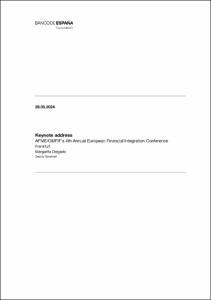Keynote address
Authors
Issue Date
28-May-2024
Physical description
7 p.
Abstract
The European banking system is well positioned. We can consider it robust, solvent and profitable. The 2023 turmoil involving some medium-sized banks in the United States and Credit Suisse proved that a sound risk management and governance structure and a strong and clear regulatory and supervisory framework are key for the stability of our financial system. Nevertheless, we must still pay close attention to the consequences that this uncertain macroeconomic and geopolitical scenario might have for the credit quality of specific portfolios. Additionally, the new monetary policy scenario also requires our banks to develop robust, diversified and credible funding plans easily to be operationalised. Banks should also set effective contingency plans to be able to withstand short-term liquidity shocks and also ensure the adequate management of their interest rate risk positions. Institutions should take advantage of the current profits to make all necessary investments to ready themselves to address the new digital and environmental risks. The world today is much more complex than 30 years ago. Competition across sectors and geopolitical blocks are even more intense and of a global scale. Meanwhile, the capital markets union should urgently and definitively gain political momentum in the next legislative cycle to strengthen and galvanise European investment and, consequently, the economy. Additionally, completing the third pillar of the banking union is another priority that must be addressed in order to achieve the full integration of our banking system.
Notes
Evento: 4th Annual European Financial Integration Conference. Organizado por: AFME/OMFIF.
Subjects
Mecanismo Único de Supervisión; Unión Económica y Monetaria; Unión Europea; Supervisión macroprudencial; Bancos; Subgobernadora
Appears in Collections:












